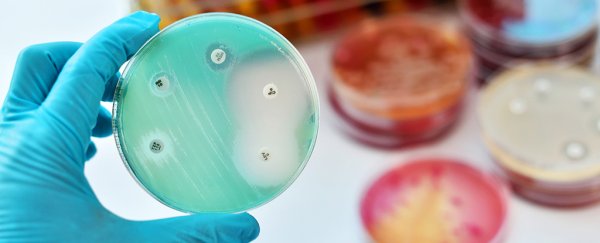Right now, it's known simply as G0775. But this simple code could represent a whole new battery of drugs that just might buy us the time we need to deal with the growing superbug problem.
By tweaking a protein that blocks a signalling process in a category of especially nasty bacteria described as gram negatives, researchers have come up with an antibiotic that won't face resistance. Not yet, at least.
Researchers from the biotechnology corporation Genentech claim it's still too early to say when – or even if – their discovery could see the light of day. But these kinds of antibiotics don't come along every day, so it's an exciting development.
Bacteria come in two flavours – gram positives, and gram negatives. We can thank the Danish bacteriologist Hans Christian Gram for the distinction; he first performed a test showing some bacteria hold a purple stain, while others do not.
That difference comes down to the arrangement of bacterial membranes and walls. Gram positives are a little like chicken eggs – a thick outer shell made of peptidoglycans (protein-sugars) enveloping a fatty membrane. This wall is what traps Gram's stain.
Many antibiotics, such as the famous penicillin family, work by interfering with the peptidoglycan wall, halting its growth while the gooey insides continue to expand.
But in gram negatives, that thin peptidoglycan layer sits between two leaky membranes. When it comes to finding drugs that can destroy bacteria, this skin sandwich makes all the difference.
While scientists have found a variety of devious ways to target the growth of gram positives, gram negatives still pose a challenge - according to researchers behind this latest discovery, that double membrane has for decades stymied the efforts to find antibiotics effective against gram negatives.
Most pathogens that have developed multiple antibiotic resistance - so-called superbugs - also happen to belong to the gram negative category. So not only is the arsenal sparse, many of the weapons we do have are increasingly ineffective.
To engineer a new weapon, researchers took a hint from a class of molecules called arylomycins, which had already shown potential as antibiotics against gram positive bacteria, like species of Staphylococcus.
These chemicals work by blocking an enzyme that snips proteins in a signalling process across the bacteria's membrane.
Because it's important for the bacteria's growth, and doesn't resemble similar processes in animals, it's a good candidate for an antibiotic. The only problem is, this snippy enzyme sits in a hard-to-reach place under the gram negatives' outer membrane.
Hard to reach doesn't mean impossible, and there were signs arylomycins could wiggle their way through. So the hunt was on for an analogue that could slip through the membrane and get to the all-important enzyme.
G0775 was the winning design.
"In this study, we used medicinal chemistry techniques to deconstruct arylomycin in order to develop select modified molecules, including G0775, that are orders of magnitude more potent than arylomycin and able to effectively penetrate the bacterial outer membrane to access signal peptidase," the researchers explain.
The drug not only makes for a stealthy assassin, it gets the job done, making short work of a panel of 'America's most wanted' pathogens – multiple antibiotic resistant gram negatives collected by the Centers for Disease Control.
Among them was one nasty strain of Klebsiella pneumoniae already resistant to 13 antibiotics. This one bacteria has health experts in a state of high alert, so having a drug that might nail it down could be vital in the coming years.
"Importantly, the unique design of G0775 and mechanism of interaction with signal peptidase allows this molecule to circumvent known mechanisms of resistance that typically manifest in gram negative bacteria," the researchers say.
Of course, bacteria aren't known for surrendering easily. It's unlikely that this would be the last antibiotic we'll ever need, as new forms of resistance evolve.
But it might buy us time. With superbugs like K. pneumoniae knocking at our door, we're going to need every opportunity we can get our hands on.
This research was published in Nature.
